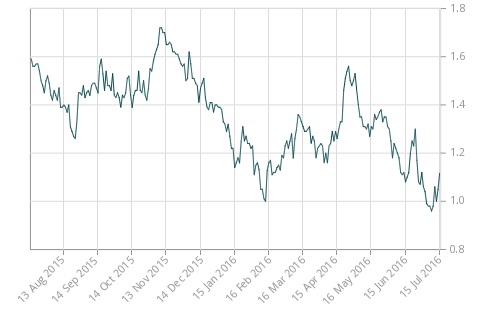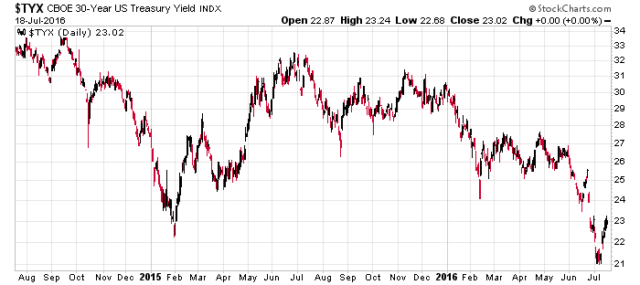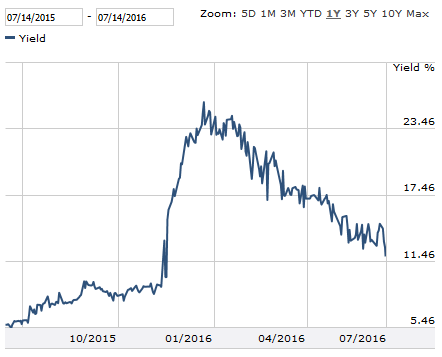Over the past couple months I have accumulated a substantial position in Teekay Corporation’s (NYSE: TK) unsecured debt, maturing January 15, 2020. The coupon is 8.5% and is paid semi-annually. I am expecting this debt to be paid out at or above par value well before the maturity date. The yield to maturity at my cost I will be receiving for this investment will be north of 20% (and obviously this number goes up if there is an earlier redemption).

I was really looking into the common shares and was asleep at the switch for these, especially around the US$7-8 level a month ago. Everything told me to pull the trigger on the commons as well, and this mistake of non-performance cost me a few percentage points of portfolio performance considering that the common shares are 50% above where I was considering to purchase them. This would have not been a trivial purchase – my weight at cost would have been between 5-10%.
However, offsetting this inaction was that I also bought common shares (technically, they are limited partnership units) of Teekay Offshore (NYSE: TOO) in mid-February. There is a very good case that these units will be selling at US$15-20 by the end of 2017, in addition to giving out generous distributions that will most likely increase in 2018 and beyond.
The short story with Teekay Corporation debt is that they control three daughter entities (Teekay Offshore, Tankers, and LNG). They own minority stakes in all three (roughly 30% for eachUpdate on April 26, 2016: I will be more specific. They have a 26% economic interest and 54% voting right in Teekay Tankers, a 35% limited partner interest in Teekay Offshore, and 31% limited partnership interest in Teekay LNG), but own controlling interests via general partner rights and in the case of Tankers, a dual-class share structure. There are also incentive distribution rights for Offshore and LNG (both of which are nowhere close to being achieved by virtue of distributions being completely slashed and burned at the end of 2015). If there was a liquidation, Teekay would be able to cover the debt with a (painful) sale of their daughter entities.
Teekay Corporation itself is controlled – with a 39% equity stake by Resolute Investments, Ltd. (Latest SC 13D filing here shows they accumulated more shares in December 2015, timed a little early.) They have a gigantic incentive to see this debt get paid off as now do I!
The mis-pricing of the common shares and debt of the issuers in question revolve around a classic financing trap (similar to Kinder Morgan’s crisis a few months ago). The material difference that the market appears to have forgotten about is that Teekay Offshore (and thus Teekay Corporation’s) business is less reliant on the price of crude oil than most other oil and gas entities. The material financial item is that Teekay Offshore faces a significant cash bridge in 2016 and 2017, but it is very probable they will be able to plug the gap and after this they will be “home-free” with a gigantic amount of free cash flow in 2018 and beyond – some of this will go to reduce leverage, but the rest of it is going to be sent into unitholder distributions assuming the capital markets will allow for an easy refinancing of Teekay Offshore’s 2019 unsecured debt.
At US$3/share, Teekay Offshore was an easy speculative purchase. Even at present prices of US$7/share, they are still a very good value even though they do have large amounts of debt (still trading at 16% yield to maturity, but this will not last long).
The absolute debt of Teekay Corporation is not too burdensome in relation to their assets, and one can make an easy guess that given a bit of cash flow through their daughter entities, they will be in a much better position in a couple years to refinance than they are at present. They did manage to get another US$200 million of this 2020 debt off at a mild discount in mid-November 2015, which was crucial to bridging some cash requirements in 2016 and 2017. The US$593 million face value of unsecured debt maturing January 2020 is the majority of the corporation’s debt (noting the last US$200 million sold is not fungible with the present $393 million until a bureaucratic process to exchange them with original notes) – I’d expect sometime in 2017 to 2018 this debt will be trading above par value.
The debt can be redeemed anytime at the price of the sum of the present values of the remaining scheduled payments of principal and interest, discounted to the redemption date on a semi-annual basis, at the treasury yield plus 50 basis points, plus accrued and unpaid interest to the redemption date.
This is a very complex entity to analyze as there is a parent and three daughter units to go through (and realizing that Teekay Corporation’s consolidated statements are useless to read without dissecting the daughter entities – this took a lot of time to perform properly). I believe I’ve cherry-picked the best of it and have found a happy place to park some US currency. I still think it is trading at a very good value if you care to tag along.



